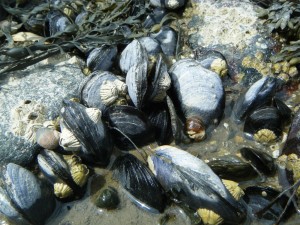by Kristen Minogue
Some species can survive just about anywhere. Take blue mussels, a group of shellfish whose habitat stretches from the Arctic to the Mediterranean. Over the last several decades, biologists have thrown all kinds of tests at them – heat, cold, saltwater, freshwater, low oxygen. They’ve even tried drying them out. Almost nothing fazes these animals. For invasion scientists trying to figure out how far they could spread, that’s a scary prospect.One species of blue mussels, Mytilus edulis, is native to regions across the Northern Hemisphere. Like local dialects of a language, every region has different varieties. But it turns out globalization is just as powerful for animals as it is for people. As cargo ships inadvertently transport them across continents, American and European mussel populations have started to mingle. They’ve also starting mixing with populations across the Equator. Abrupt changes in salinity and temperature that would spell certain death for other creatures don’t seem to fluster them.
Their survival record looks something like this. Mytilus edulis is used to living in saltwater (about 30 parts per thousand), but it has been known to grow in salinities as low as 4 ppt. In the past scientists thought extreme temperatures would keep the mussels in check. However, scientists have seen them stay alive in temperatures as low as -10°C and as high as 29°C. There even have been reports of populations that survived for weeks buried under the ice.
This winter an intern in the marine invasions lab, Matt Siskey, tried another extreme. Mytilus edulis has already shown it can cope with gradual changes in temperature. So instead of merely turning up the heat, he tested what happens when it gets turned up fast, part of a project run by Research Fellow Dr. Louise McKenzie.

Blue mussels from Sachuest. Conditions appeared harsher in the Sachuest zone, so Siskey speculates this made their shells thicker and more rugged. (Credit: Matt Siskey/SERC)
Once finished, preliminary results suggested the total number of blue mussels killed or harmed by the experiment was…zero. In fact, the only mussels that showed any change whatsoever actually seemed to improve. That group, from Sachuest Nature Preserve in southeastern Rhode Island, lived in an intertidal zone where low tides exposed them to the elements. While Siskey did test mussels from another intertidal zone, rough observations implied Sachuest wasn’t as pleasant a place to live. Compared with their natural habitat, Siskey speculates his experiment might have felt like a vacation for the Sachuest mussels.
That said, the title “toughest shellfish in the sea” may not belong to Mytilus edulis alone. Many species of mussels are just as resilient to extreme temperature ranges. If the ocean does hold more species like M. edulis that can migrate almost anywhere, ecosystems all over the globe could face drastic population changes in the years to come.



I had no idea that all these kinds of shellfish are so resistent. Truely impressive!
Now, we can say : Tough like a mussel! And there are very delicious.
I never knew this kind of fish exist. Very nice article. Keep writing